Phoenix Rising have been one of the more dominant forces in the USL Championship in the past couple of years. Head Coach Rick Schantz has been a key part of their success, boasting a record of 43 wins, eight draws, and 17 losses during his 68 matches in charge. One of the core reasons for Rising’s success under Schantz is their ability to attack and to score.
This tactical analysis will examine the tactics Schantz has put in place in regards to Phoenix’s attack. The analysis will mainly focus on the front six of their 4-3-3 formation, and what roles they play when they go forward.
Overview
Last year, Rising averaged 2.4 goals per game by generating 1.91 xG per match. While the data sample is smaller, they’ve improved upon that this year, averaging 2.8 goals per game while generating 2.2 xG at the time of writing. This likely comes from an increase in key passes (18 this season compared to 15 last season) at a higher success rate than last year. So far, they’ve created a total of 29 chances, scoring 11 goals in the process. This comes with an 82% pass success rate, which should be one of the more encouraging factors. If Rising can increase that pass success rate by picking out smarter passes, they’ll likely generate more scoring opportunities in the process. In terms of production, one needs to look no further than captain Solomon Asante, who leads the team in goals (tied with Junior Flemmings), chances created, shots on target, key passes, and accurate crosses.
Play of the wingers
Asante and Flemmings typically play on the wings, with Asante on the right and Flemmings on the left. Asante plays as a natural winger while Flemmings functions most often as an inverted winger. Both are incredibly fast, which the midfield often looks to exploit. Their ability to use their speed is often paired with their excellent positioning, which can be highlighted from Rising’s recent match against LA Galaxy II.
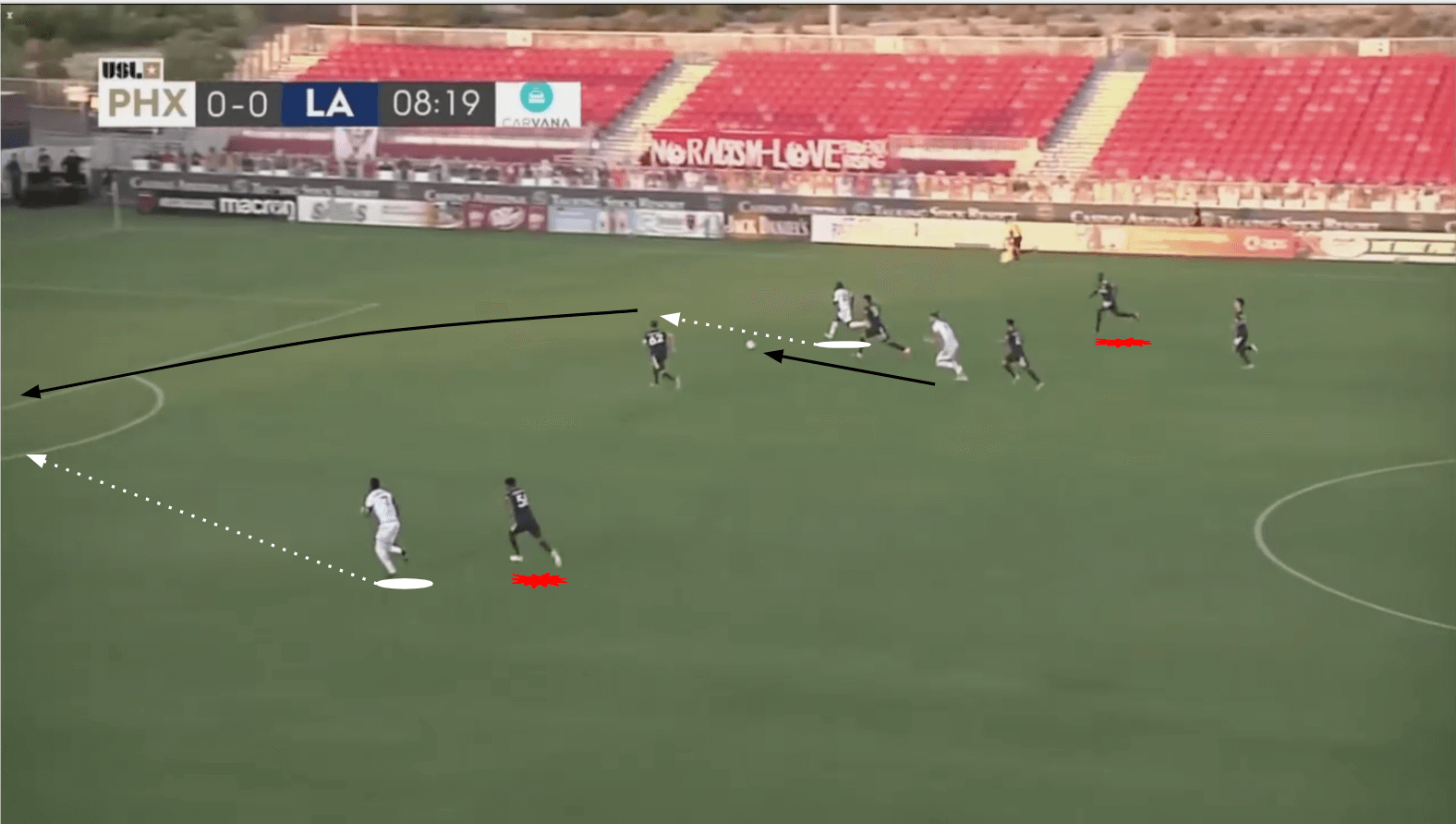
In the image above, note the positioning of both Flemmings (bottom of the image) and Asante (top of image) in relation to their respective outside backs, who are marked in red. Phoenix had recently won the ball in their own half before playing a pass up to their centre-forward, Rufat Dadashov. These two typically take up positions in the space between the centre-backs and the outside-backs, creating defensive confusion in the process. When opponents’ outside-backs push forward, Asante and Flemmings don’t typically follow them immediately, giving them a head start and making it nearly impossible for them to be caught.
Another important aspect of play in the image above is Asante’s use of the forward cross. A forward cross is used most effectively when there is a single line of defenders; it becomes incredibly challenging to defend because defenders can only watch either the ball or their opponent (and they usually opt for the ball). The ball is played as an outswinging cross, ideally to the space between the 6-yard box and the edge of the penalty area, making it nearly impossible for goalkeepers to catch. Asante serves these up on a consistent basis, and it’s one of the more dangerous tools he has in his game.
Both players are adept at receiving and playing in the half-space as well. While they both do it, they certainly have different styles of doing so.
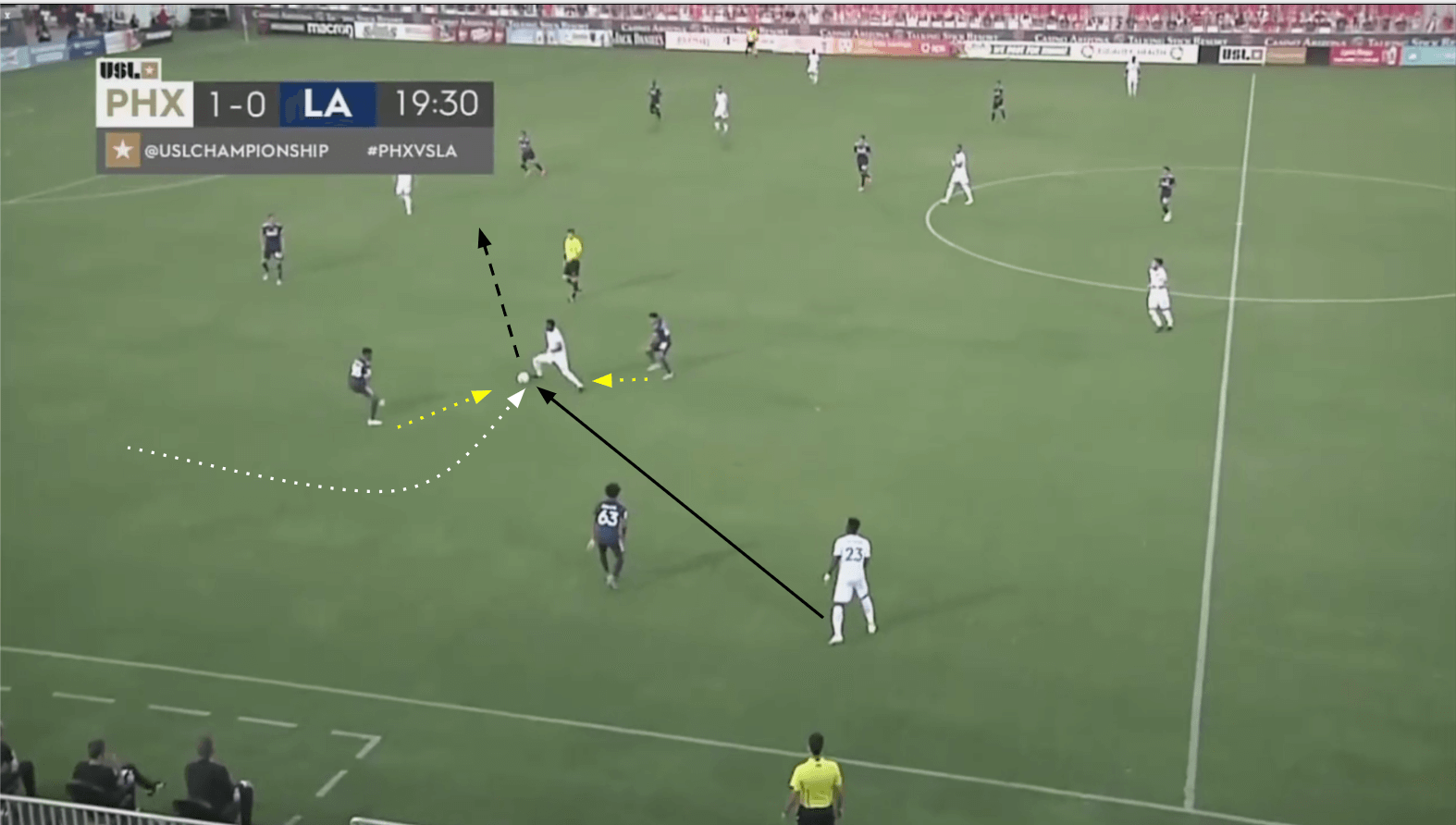
Flemmings, as previously stated, is naturally right-footed and certainly favours it, so his ability to receive passes properly in the half-space depend upon the location of the passer. When the ball comes from an exterior zone, he can use his right foot to receive and turn. The image above highlights this and how effective it is. Flemmings checked into the half-space from his position on the wing, bringing the right-back with him. When the pass was played in, Flemmings drew the attention of two LA defenders before turning into the space behind him. This allowed him to dribble at central defenders and engage them, creating space for teammates in the process. Another way in which Flemmings likes to cut inside is with his first touch on his right foot. He will find space either next to or in front of a defender in order to receive the ball from his midfield.
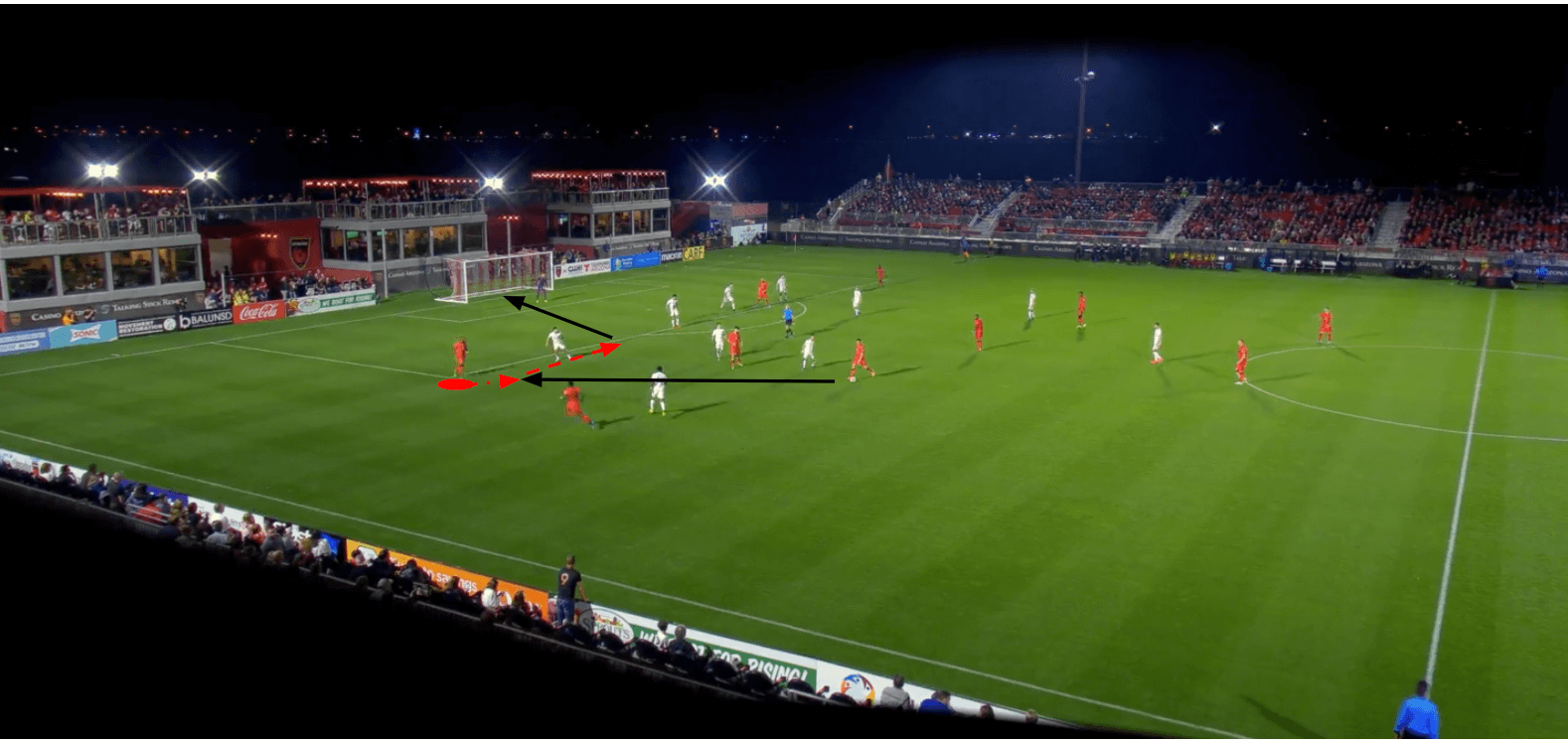
Flemmings first move is to attack the pass: instead of waiting for it, he takes one to two steps towards it, sealing off his defender in the process. Flemmings will then use his first touch with his right foot to cut into the centre of the pitch. This is when it becomes dangerous for defenders, because they either have to follow him as he dribbles across the pitch or ‘pass’ him off to other defenders. This is incredibly similar to what Leo Messi does at Barcelona. In the instance above, the two Portland Timbers 2 players actually ran into each other, allowing Flemmings to essentially pass the ball into the back of the net.
Asante also has the freedom to occupy the half-space to receive the ball. Sometimes he’ll do so by dropping down in between the lines of pressure; other times he’ll just maintain that position while still in between the centre-back and left-back, as he did below.
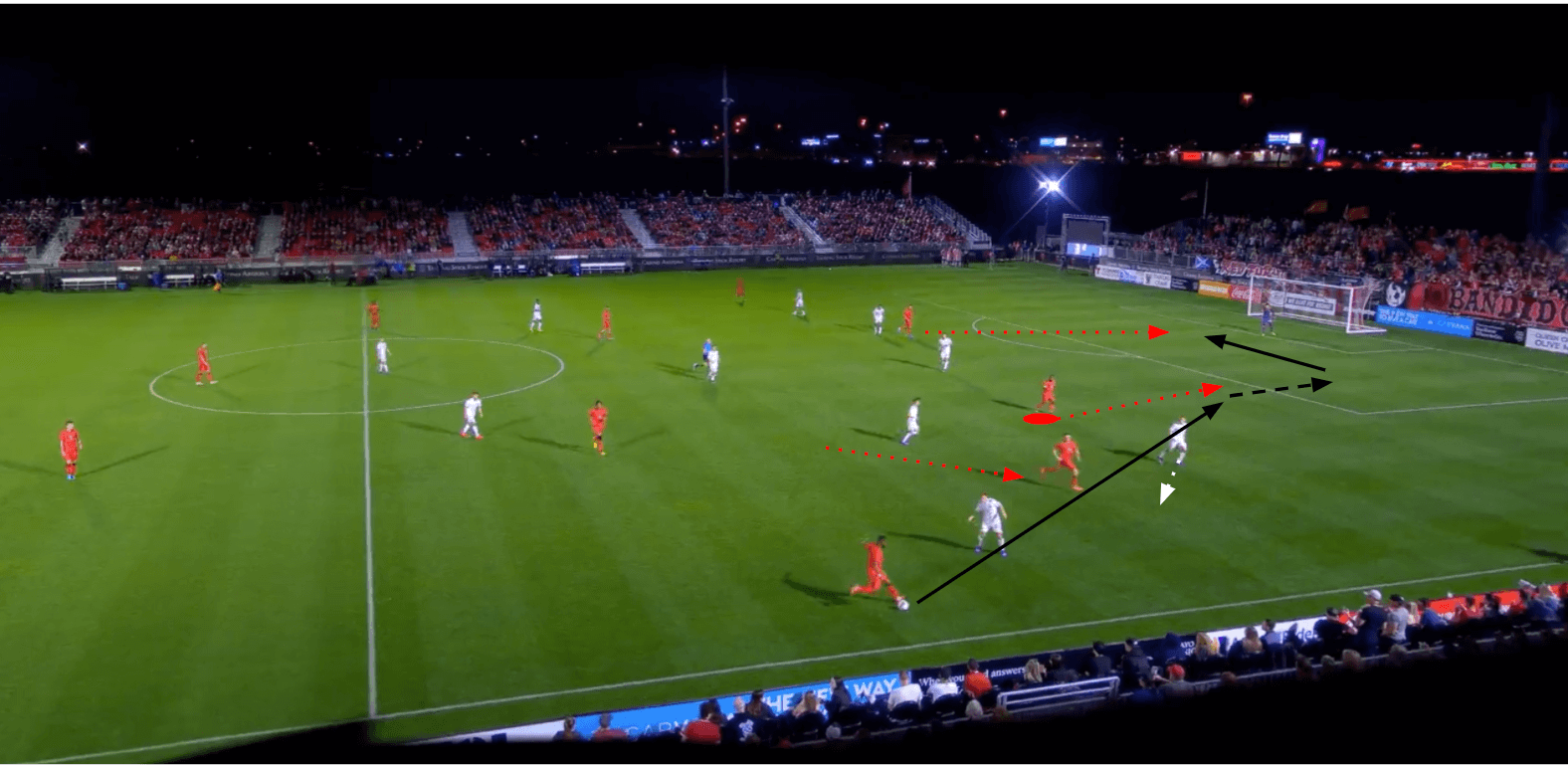
While there are a lot of moving pieces that allow this goal to happen, the most important one is Asante’s positioning between the two aforementioned defenders. As a run from midfield towards the wing drew the attention of the left-back, the ball was played in over the top. Asante can run from the half-space to get onto it, and from there, it’s a textbook cross to Dadashov, who buried the ball in the back of the net.
Dadashov’s role in attack
Rufat Dadashov, who spent time in the lower levels of the Bundesliga, was brought in during the offseason to replace Adam Jahn, who now plays for Atlanta United in the MLS. While people love to talk about replacing player’s statistics, in this case, Jahn’s 18 goals and eight assists, the real struggle can be making sure a player fits in tactically and can help contribute. This adjustment can take some players weeks or months; luckily for Phoenix, Dadashov has fit into Rising’s attack quite well due to his positional intelligence and his hold-up play.
While Dadashov isn’t a false nine who will drop in between lines and pop up all over the attacking third, his ability to connect with teammates when his back is to goal makes him such an asset to Rising. In Rising’s first match against Orange County, Dadashov played Asante into space off of a headed flick while registering an assist on Junior Flemmings goal by again flicking a headed ball to a teammate. In their second match against Orange County, Dadashov highlighted his deft first touch.
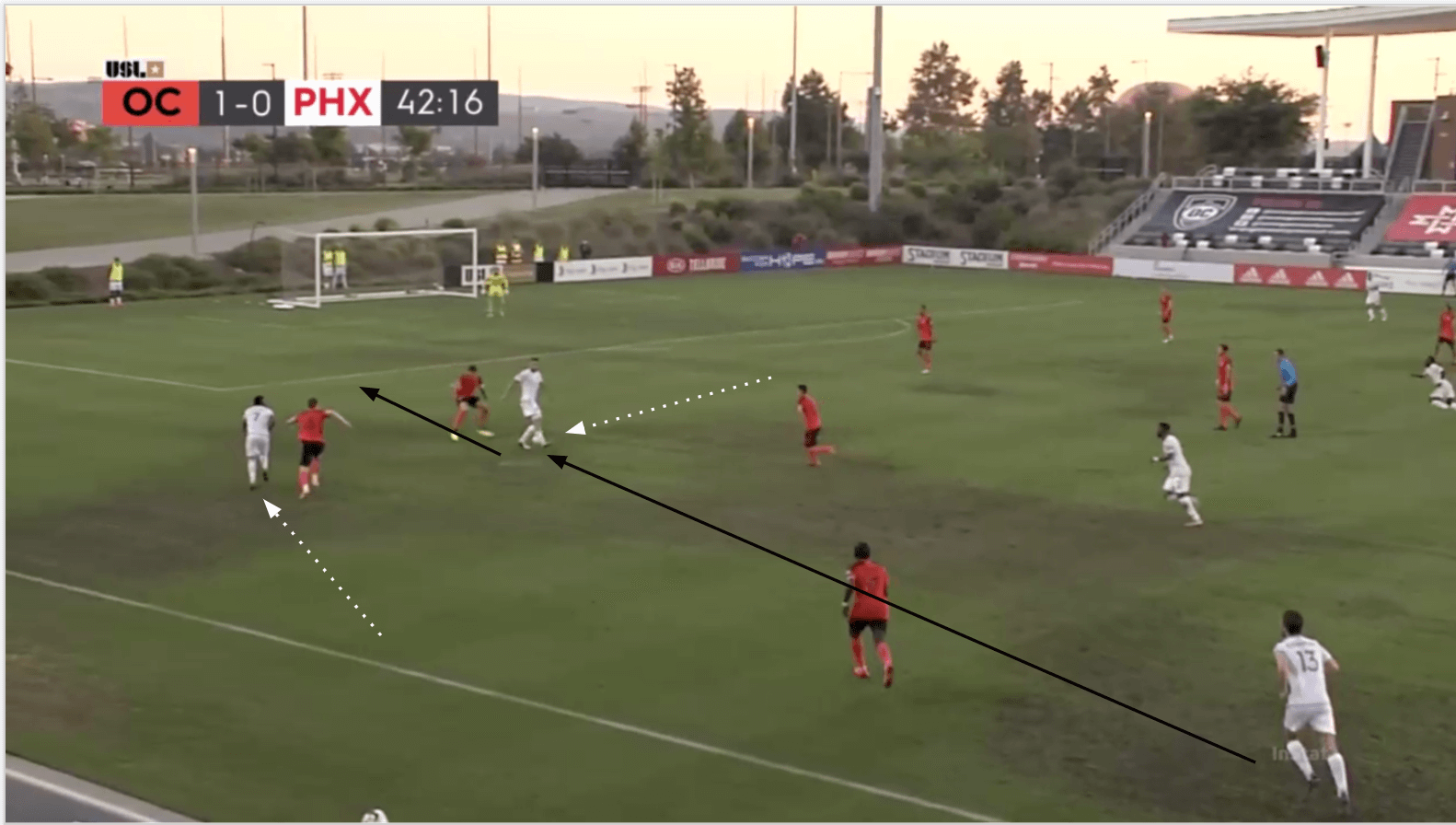
As the ball moved from the centre of the pitch to the left side, Dadashov followed. He did well to recognise the gap between the two defenders and received a bouncing ball played into his feet. With his first touch, Dadashov was able to redirect the pass and put it directly into the path of Flemmings. Dadashov was able to recognise the space behind him and slotted Flemmings in on goal, where Flemmings tried but failed to chip the goalkeeper. Dadashov uses these flicks on deft touches multiple times throughout the match, utilising Flemmings’ and Asante’s speed to get in behind the defence. What makes Dadashov such a threatening scorer (currently tied with Flemmings and Asante at the time of writing) is his positioning in relation to his opponents.
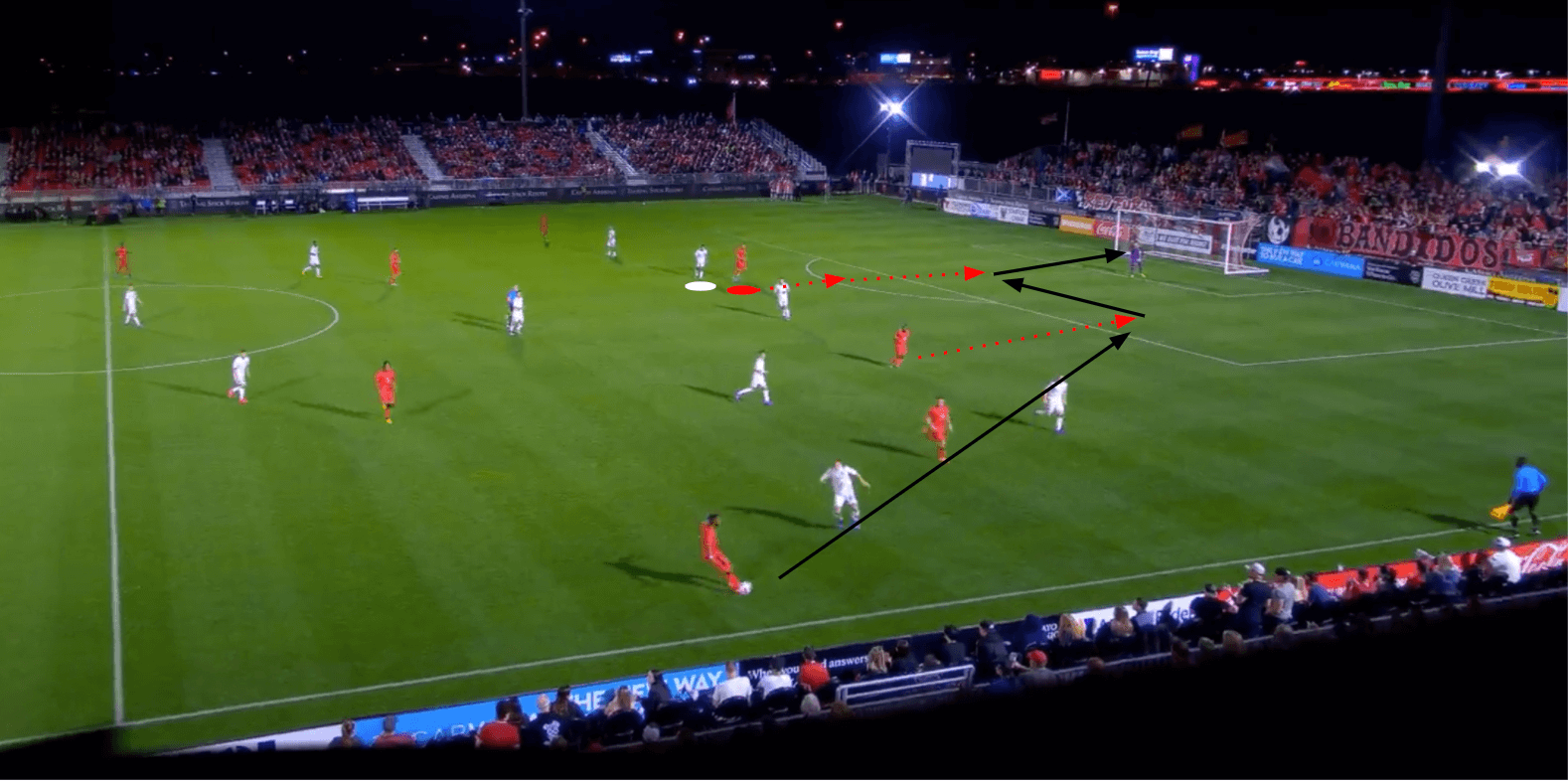
One example of his excellent positioning is shown above. Dadashov started in an offside position. This is frustrating for defenders already because they’re trying to watch the ball, while watching him, while also knowing he can’t technically threaten the goal because he is in an offside position. As the ball was played to Asante, Dadashov’s first couple of steps allowed him to seal off his defender, who is marked in white. Instead of running directly at the goal, he ran at an angle that eliminated his defender from the play by essentially making sure there was no way the defender could get around him. Dadashov mirrored the defender’s movements to prevent him from doing so. All he had to do was wait for Asante to progress in front of him so that he could be onside, and then finish the chance into the back of the net.
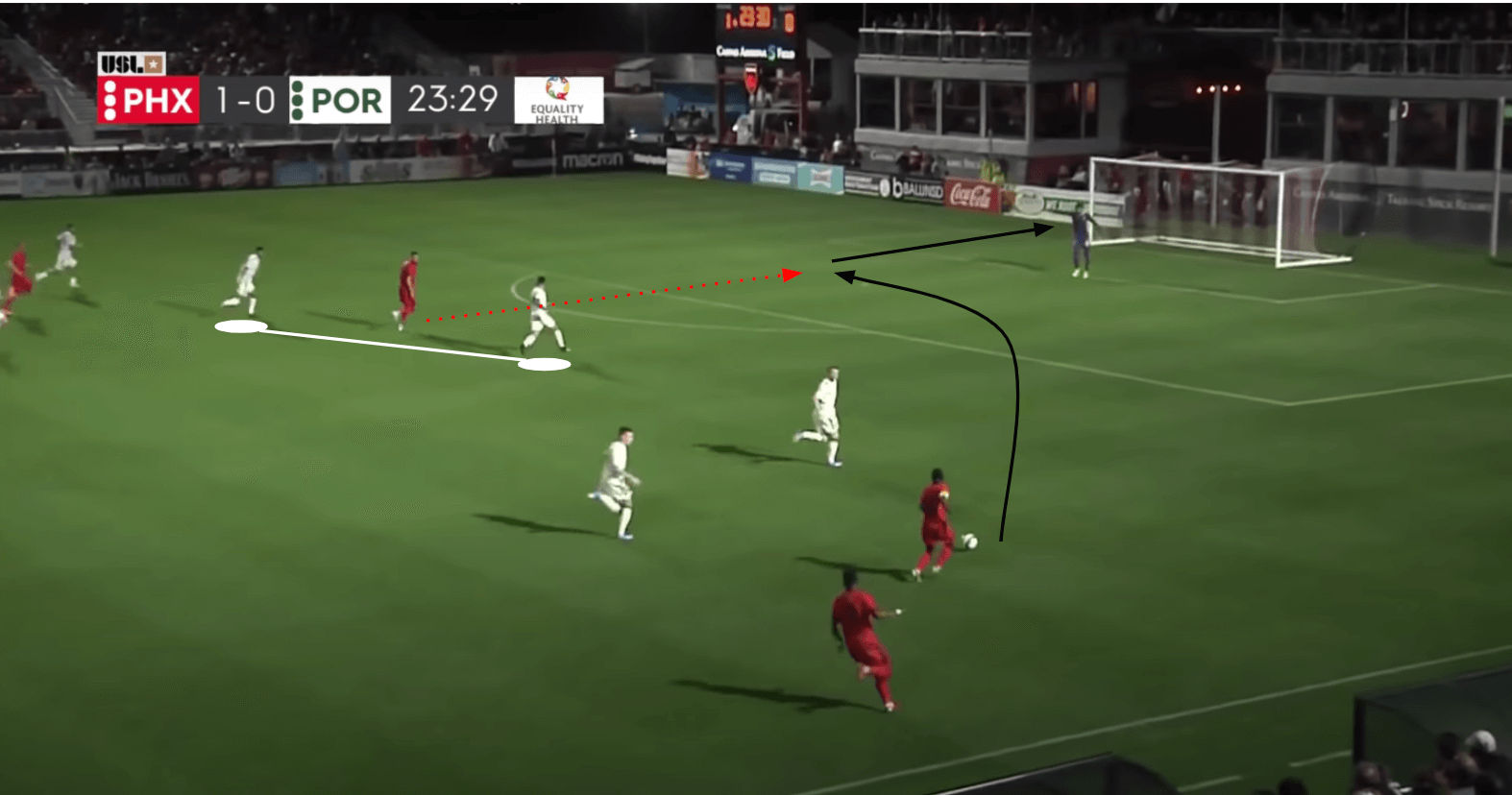
As previously explained, Rising’s wingers, especially Asante, utilise the forward cross on a fairly consistent basis. While oftentimes the opposite winger will be the goal scorer with the forward cross, Dadashov’s positioning in relation to his opponent makes him a constant threat. In the image above, Dadashov had positioned himself directly between the two centre-backs. The near-side centre-back wasn’t sure he was there until he fully turned to check his shoulder. At this same moment, Dadashov and Asante are making eye contact, signalling an incoming cross. As soon as the defender turned back to face the ball, Asante delivered the pass and Dadashov sprinted forward into the space in front of him, putting the cross into the back of the net with his first touch. In this instance, Dadashov’s positioning, movement, and timing make him a welcomed addition to the Rising front line, and he will certainly cause problems for USL defences alongside Flemmings and Asante.
The roles of the midfield
Rick Schantz has previously explained that he likes all three of his midfielders in their typical 4-3-3 to operate as 8s, meaning they should be able to help with transitions, progress the ball, and generally serve as box-to-box midfielders. This does allow for a large amount of rotation between the three of them. While Kevon Lambert typically plays as the holding midfielder and Jon Bakero certainly has attacking-midfielder tendencies, the flexibility of the three midfielders is certainly an advantage. One of the strengths of the midfield is their ability to enter the half-spaces and distribute from there.
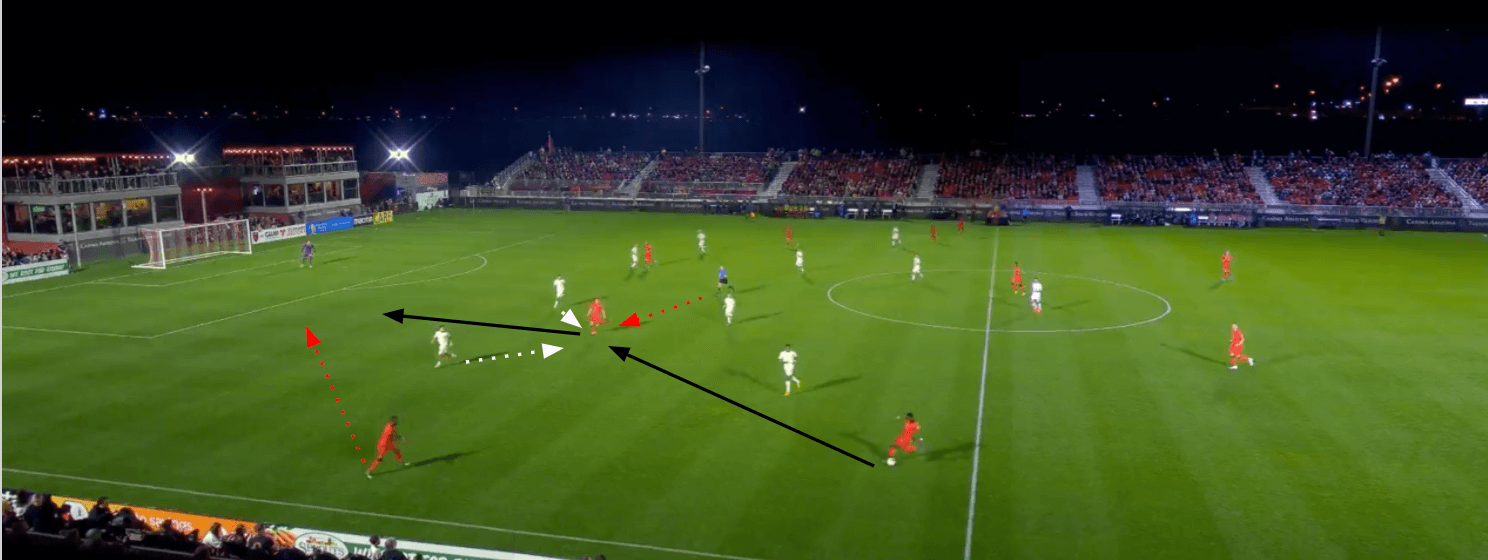
The first example comes from Sam Stanton, who began the move by providing Lambert with an excellent opportunity to break a defensive line of pressure. Lambert opted for the safer pass, playing the ball to Owusu-Ansah Kontor, the left-back. Stanton again showed for Kontor inside the half-space; as the pass was played, the right-back and centre-back of the Timbers 2 team followed the ball. Because of Stanton’s excellent positioning, he was able to receive the ball and split the final line of defensive pressure, slotting a pass to a streaking Junior Flemmings. This quick succession of passes can often be devastating, but the midfielders often use runs from the half-space to open up space for their teammates.
In the image below, the creation of space is shown. Kevon Lambert had just played a diagonal ball to Solomon Asante on the right-wing. As Asante dribbled at his defender, José Aguinaga, who had subbed on for Jon Bakero, made a great run from the half-space towards the corner.
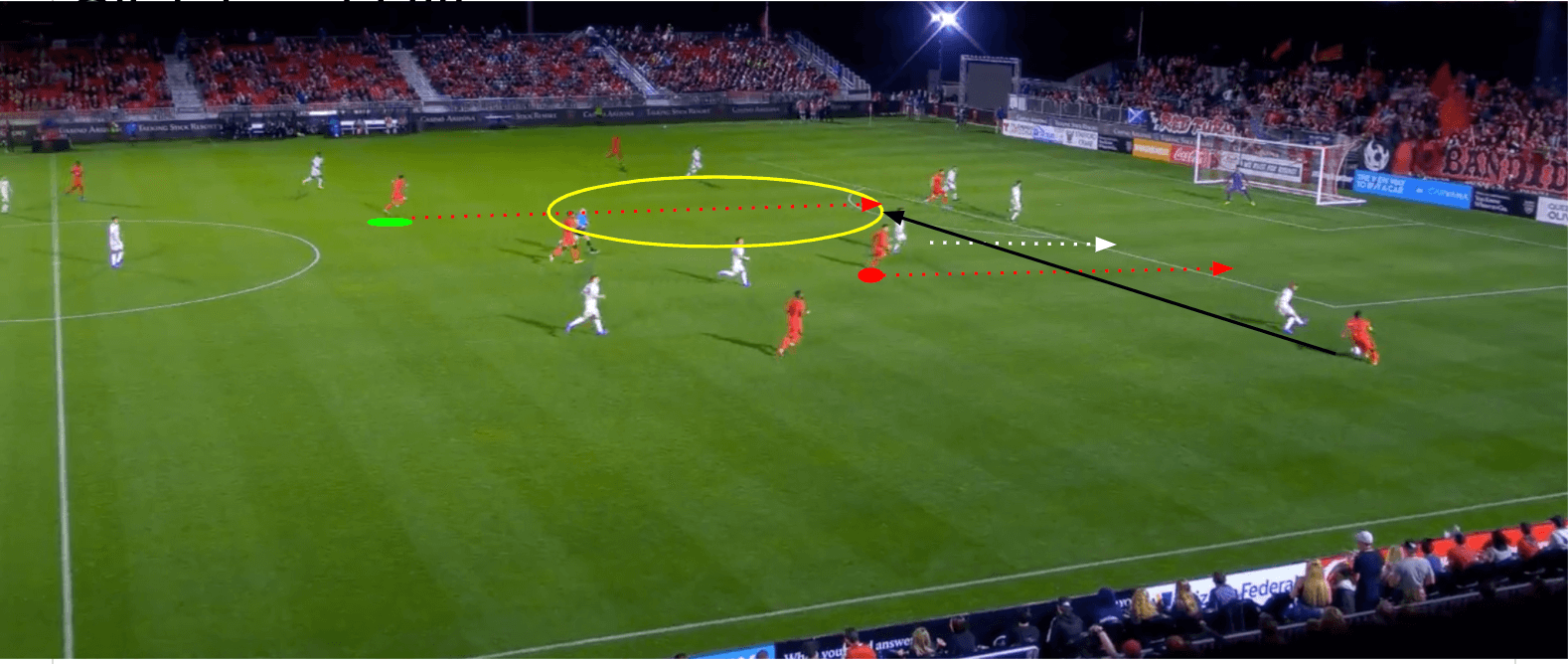
As he made his run, his defender followed him closely. This opened up a large amount of room directly in front of the penalty area. Jordan Schweitzer, who had subbed on for Stanton, recognised the run Aguinaga made, as well as the space available. Schweitzer sprinted into the space from the middle third of the pitch and had a wide-open chance, but his shot was drilled directly at the goalkeeper. While the shot didn’t go it, the ability to recognise space and exploit it allows Rising’s attack to move more fluidly, making it difficult for defenders. The fact that Rising has at least five men in the middle of the pitch who can manipulate space and attract defenders makes it a nightmare for opponents.
The final piece of the midfield that makes Rising such a multi-faceted attack is their ability to take advantage of the team’s transition from defence to attack. This comes from the recognition of available space and the ability to pick out a pass to get the ball there. To do this successfully, their midfielders must have their heads up, looking for that space, even when they’re not in possession. The example below shows just that.

After a Timbers 2 goal kick, Phoenix won the aerial battle and the ball fell to Bakero’s feet. Bakero had clearly already identified how much space was available behind Timbers 2’s defensive line, because he used his first touch to settle the ball and then curled a pass onto the foot of Flemmings just outside of the penalty area. Passes like that are one of the keys for Phoenix’s impressive goal tally this season: they look to take advantage of the speed of their wingers during the transition from defence to attack by quickly playing the ball out of pressure. While the wingers get praised for goals and assists, those first balls out of pressure and into space make the entire attack spring to life.
Conclusion
Ultimately, this scout report shows that the Rising will continue to have an incredibly fluid, fast-paced attack as they have for the last few seasons under Schantz. With their front three solidified with the addition of Dadashov and their midfield firing on all cylinders with at least five men who can step in and play, the Rising certainly have the potential to challenge for the USL Championship this year.





Comments